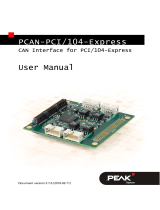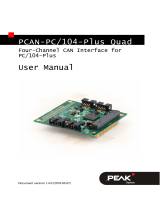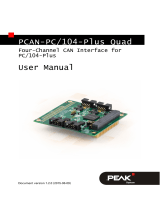Page is loading ...

PCAN-PCI/104-Express
FD
CAN FD Inter
f
ace
f
or PCI/104
Express
User Manual
Document version 1.1.0 (2019-05-24)

PCAN-PCI/104-Express FD – User Manual
2
Relevant products
Product name Model Part number
PCAN-PCI/104-Express FD Single Channel
PCAN-PCI/104-Express FD Dual Channel
PCAN-PCI/104-Express FD Four Channel
One CAN channel
Two CAN channels
Four CAN channels
IPEH-004080
IPEH-004081
IPEH-004082
The cover picture shows the product PCAN-PCI/104-Express FD Four Channel. Other
product models have an identical form factor but vary in equipment.
On request you can get the product versions with stack-through connectors for the
PCI bus.
PCAN® is a registered trademark of PEAK-System Technik GmbH. CANopen® and
C
iA® are registered community trade marks of CAN in Automation e.v.
All other product names mentioned in this manual may be the trademarks or
registered trademarks of their respective companies. They are not explicitly marked
by “™” and “®”.
Copyright © 2019 PEAK-System Technik GmbH
Duplication (copying, printing, or other forms) and the electronic distribution of this
document is only allowed with explicit permission of PEAK-System Technik GmbH.
PEAK-System Technik GmbH reserves the right to change technical data without
prior announcement. The general business conditions and the regulations of the
license agreement apply. All rights are reserved.
PEAK-System Technik GmbH
Otto-Roehm-Strasse 69
64293 Darmstadt
Germany
Phone: +49 (0)6151 8173-20
Fax: +49 (0)6151 8173-29
www.peak-system.com
info@peak-system.com
Doc
ument version 1.1.0 (2019-05-24)

PCAN-PCI/104-Express FD – User Manual
3
Contents
1 Introduction 5
1.1 Properties at a Glance 6
1.2 System Requirements 7
1.3 Scope of Supply 7
2 Installing the Software and the Card 8
3 Connecting a CAN Bus 10
3.1 Connection over D-Sub Connector 10
3.2 Slot Bracket(s) with D-Sub Connector(s) 12
3.3 Voltage Supply of External Devices 13
3.4 Activating the Daisy Chain 15
3.5 Activating the Internal Termination 18
3.6 Cabling 20
3.6.1 Termination 20
3.6.2 Example of a Connection 20
3.6.3 Maximum Bus Length 21
4 Software and API 22
4.1 Monitor Software PCAN-View 22
4.1.1 Receive/Transmit Tab 25
4.1.2 Trace Tab 27
4.1.3 PCAN-PCI/104-Express FD Tab 28
4.1.4 Bus Load Tab 29
4.1.5 Error Generator Tab 30
4.1.6 Status Bar 31
4.2 Linking Own Programs with PCAN-Basic Version
4 or Higher 32
4.2.1 Features of PCAN-Basic 33
4.2.2 Principle Description of the API 34
4.2.3 Notes about the License 35

PCAN-PCI/104-Express FD – User Manual
5
1 Introduction
The PCAN-PCI/104-Express FD allows the connection of PCI/104-
Express systems to CAN and CAN FD buses. The PCI/104-Express
specification establishes PCI Express for the PC/104 form factor
wherewith up to four cards can be stacked. Based on this,
standardized modular embedded systems such as industrial PCs
can be realized.
The CAN bus is connected via 9-pin D-Sub connectors to the
supplied slot brackets. There is a galvanic isolation between the
computer and the CAN side up to 500 Volts. The card is available as
a single, dual, or four-channel version.
The new CAN FD standard (CAN with Flexible Data rate) is primarily
characterized by higher bandwidth for data transfer. The maximum
of 64 data bytes per CAN FD frame (instead of 8 so far) can be
transmitted with bit rates up to 12 Mbit/s.
CAN FD is downward-compatible to the CAN 2.0 A/B standard, thus
CAN FD nodes can be used in existing CAN networks. However, in
this case the CAN FD extensions are not applicable.
The monitor software PCAN-View and the programming interface
PCAN-Basic for the development of applications with CAN
connection are included in the scope of supply and support the new
CAN FD.
Device drivers exist for different operating systems, so programs
can easily access a connected CAN bus.
Tip: At the end of this manual (Appendix C) you can find a
Quick Reference with brief information about the installation
and operation of the PCAN-PCI/104-Express FD card.

PCAN-PCI/104-Express FD – User Manual
6
1.1 Properties at a Glance
PCI/104-Express card, 1 lane (x1)
Form factor PC/104
Up to four cards can be used in one system
1, 2, or 4 High-speed CAN channels (ISO 11898-2)
Complies with CAN specifications 2.0 A/B and FD
CAN FD support for ISO and Non-ISO standards switchable
CAN FD bit rates for the data field (64 bytes max.)
from 20 kbit/s up to 12 Mbit/s
CAN bit rates from 20 kbit/s up to 1 Mbit/s
Connection to CAN bus through D-Sub slot bracket, 9-pin
(in accordance with CiA® 303-1)
FPGA implementation of the CAN FD controller
MCP2558FD CAN transceiver
Galvanic isolation on the CAN connection up to 500 V,
separate for each CAN channel
CAN termination can be activated through a solder jumper,
separately for each CAN channel
5-Volt supply to the CAN connection can be connected through
a solder jumper, e.g. for external bus converter
PCIe data transfer via bus master DMA
DMA memory access operations with 32- and 64-bit addresses
Measurement of bus load including error frames and overload
frames on the physical bus
Induced error generation for incoming and outgoing CAN
messages
Optionally available: PCI-104 stack-through connector

PCAN-PCI/104-Express FD – User Manual
7
Extended operating temperature range from -40 to 85 °C
(-40 to 185 °F)
Note: This manual describes the use of the PCAN-PCI/104-
Express FD with Windows. You find device drivers for Linux
and the corresponding application information on the provided
DVD in the directory branch Develop and on our website at
www.peak-system.com/linux.
1.2 System Requirements
PC/104 stack with PCIe/104 connectivity to the host
Windows 10, 8.1, 7 (32/64-bit) or Linux (32/64-bit)
1.3 Scope of Supply
PCAN-PCI/104-Express FD card, 1 Lane (x1)
Slot bracket with D-Sub connector(s) for the CAN bus
(two for the four-channel version)
Device drivers for Windows 10, 8.1, 7 and Linux (32/64-bit)
CAN monitor PCAN-View for Windows
Programming interface PCAN-Basic for developing applications
with CAN connection
Programming interfaces for standardized protocols from the
automotive sector
Manual in PDF format

PCAN-PCI/104-Express FD – User Manual
8
2 Installing the Software and
the Card
This chapter covers the software setup for the PCAN-PCI/104-Express
FD card in Windows and the installation of the card in the PC/104 stack.
Install the driver before
you insert the card.
Do the following to install the driver:
1. Start Intro.exe from the supplied DVD.
The navigation program starts.
2. In the main menu, select Drivers and click on Install now.
3. Confirm the message of the User Account Control related to
"Installer database of PEAK Drivers".
The driver setup starts.
4. Follow the program instructions.
Do the following to insert the card into the stack:
Attention! Electrostatic discharge (ESD) can damage or destroy
components on the card. Take precautions to avoid ESD.
1. Shut down the computer.
2. Disconnect the computer’s power supply.
3. Insert the card into the stack next to the host or to another
PCI/104-Express FD card.
A maximum of four
PCI/104-Express FD cards per stack is
possible. Either all are on top or beneath the host.
4. Plug a cable from the slot bracket to a 10-pin socket for each
CAN connection.

PCAN-PCI/104-Express FD – User Manual
9
5. Reconnect the computer power supply.
6. Turn on the computer and start Windows.
Windows detects the new hardware and completes the driver
installation.
Do the following to check the operational readiness:
1. Open the Windows Start menu.
2. Type peakcpl and press Enter .
The information window for PEAK hardware appears. The plug-in
card must be displayed in the table on the CAN Hardware tab.

PCAN-PCI/104-Express FD – User Manual
10
3 Connecting a CAN Bus
3.1 Connection over D-Sub Connector
The High-speed CAN bus (ISO 11898-2) is connected to the 9-pin
D-Sub connector. The pin assignment for CAN corresponds to the
specification CiA® 303-1.
Figure 1: Position of the sockets on the four-channel card (IPEH-004082);
dual channel card (IPEH-004081) only CAN 1 and CAN 2;
single channel card (IPEH-004080) only CAN 1
Figure 2: Pin assignment of High-speed CAN

PCAN-PCI/104-Express FD – User Manual
11
Low power devices (e.g. bus converters) can be supplied directly
with 5 volts over pin 1 of the CAN connector. Pin 1 is not in use at
the delivery state. For more information, see the next section 3.3.
The
pin assignment between the D-Sub port and the 10-pin
connector on the PCAN-PCI/104-Express FD card is as follows:
Figure 3: Numbering at the 10-pin connector on the board
Pin Assignment Assignment
D-Sub
1 +5 V (optional) 1
2 GND 6
3 CAN_L 2
4 CAN_H 7
5 GND 3
6 not connected 8
7 not connected 4
8 not connected 9
9 not connected 5
10 not connected
Tip: Connect a CAN bus with a different transmission standard
via a bus converter. PEAK-System offers different bus converter
modules like the PCAN-TJA1054 for a Low-speed CAN bus
according to ISO 11898-3.

PCAN-PCI/104-Express FD – User Manual
12
3.2 Slot Bracket(s) with D-Sub
Connector(s)
Figure 4: Single channel slot bracket Figure 5: Dual channel slot bracket
To connect a CAN bus to the PCAN-PCI/104-Express FD card, use
the supplied slot bracket(s). After you have connected the flat-
ribbon cables from the slot bracket(s) with the 10-pin sockets, you
can connect the CAN buses with the D-Sub sockets.

PCAN-PCI/104-Express FD – User Manual
13
3.3 Voltage Supply of External Devices
External devices with low power consumption (e.g. bus converters)
can be directly supplied via the CAN connector. With a solder bridge
per CAN channel on the PCAN-PCI/104-Express FD board, a 5-Volt
supply can optionally be routed to pin 1 of the D-Sub connector.
The current output is limited to 50 mA.
Important note: The optional 5-Volt supply can not be operated
simultaneously with the daisy chain.
Do the following to activate the voltage supply:
Risk of short circuit! Solder with great care to avoid unwanted
short circuits on the card.
Attention! Electrostatic discharge (ESD) can damage or destroy
components on the card. Take precautions to avoid ESD.
Set the solder bridges corresponding to the desired settings.
Figure 6 on page 14 shows the solder field positions on the four-
cha
nnel card (IPEH-004082). The solder fields for the single and dual
channel versions (IPEH-004080/81) are located in the same positions
and can therefore also be taken from this figure. The table below
contains the possible settings.
Risk of short circuit! The 5-Volt supply is not protected
separately. Therefore, turn off the computer before you
connect and disconnect CAN cables or peripheral systems.

PCAN-PCI/104-Express FD – User Manual
14
Figure 6: Position of the solder fields on the top side
of the four-channel card (IPEH-004082) for a 5-Volt supply;
dual channel card (IPEH-004081) only CAN 1 and CAN 2;
single channel card (IPEH-004080) only CAN 1
5-Volt supply
D-Sub
connector
Solder field
Without
(standard)
Active
(Pin 1)
CAN1
JP1
CAN2
JP13
CAN3
JP16
CAN4
JP19

PCAN-PCI/104-Express FD – User Manual
15
3.4 Activating the Daisy Chain
The daisy chain can be activated via solder jumpers on the board to
connect a CAN FD optimized connection to an existing CAN bus.
This makes interference-free operation possible at higher CAN FD
bit rates, because stubs and Y distributions are largely avoided.
Important note: The optional daisy chain can not be operated
simultaneously with the 5-Volt supply.
When the daisy chain is activated, the pin assignments on the
D-Sub and 10-pin connectors change as follows:
Figure 7: Pin assignment of High-speed CAN and daisy chain
Figure 8: Numbering at the 10-pin connector on the board
Pin Assignment Assignment
D-Sub
1 CAN-L daisy chain 1
2 GND 6
3 CAN_L 2
4 CAN_H 7

PCAN-PCI/104-Express FD – User Manual
16
Pin Assignment Assignment
D-Sub
5 GND 3
6 CAN-H daisy chain 8
7 not connected 4
8 not connected 9
9 not connected 5
10 not connected
Do the following to activate the daisy chain:
Risk of short circuit! Solder with great care to avoid unwanted
short circuits on the card.
Attention! Electrostatic discharge (ESD) can damage or destroy
components on the card. Take precautions to avoid ESD.
Set the solder bridges corresponding to the desired settings.
Figure 9 on page 17 shows the solder field positions on the four-
cha
nnel card (IPEH-004082). The solder fields for the single and dual
channel versions (IPEH-004080/81) are located in the same positions
and can therefore also be taken from this figure. The table below
contains the possible settings.

PCAN-PCI/104-Express FD – User Manual
17
Figure 9: Position of the solder fields on the top side
of the card (IPEH-004082) for the activation of the daisy chain
dual channel card (IPEH-004081) only CAN 1 and CAN 2;
single channel card (IPEH-004080) only CAN 1
Daisy chain
D-Sub
connector
Solder fields
Without
(standard)
Active
CAN1 JP10 and JP11
CAN2 JP12 and JP14
CAN3 JP15 and JP17
CAN4 JP18 and JP20

PCAN-PCI/104-Express FD – User Manual
18
3.5 Activating the Internal Termination
The internal termination can be activated by solder jumpers on the
PCAN-PCI/104-Express FD board, to terminate one end of the CAN
bus with 120 Ohms. At delivery the termination is not activated. A
High-speed CAN bus (ISO 11898-2) must be terminated on both
ends with 120 Ohms. Otherwise disturbances may arise.
Do the following to activate the internal termination:
Risk of short circuit! Solder with great care to avoid unwanted
short circuits on the card.
Attention! Electrostatic discharge (ESD) can damage or destroy
components on the card. Take precautions to avoid ESD.
Set the solder bridges corresponding to the desired settings.
Figure 10 on page 19 shows the positions of the solder fields of the
four
-channel card (IPEH-004082). The solder fields for the single and
dual channel card (IPEH-004080/81) are located in the same
positions and can therefore also be taken from Figure 10. The table
be
low contains the possible settings. The table below contains the
possible settings.

PCAN-PCI/104-Express FD – User Manual
19
Figure 10: Position of the solder fields on the top side of the
four-channel card (IPEH-004082) for the internal termination;
dual channel card (IPEH-004081) only CAN 1 and CAN 2;
single channel card (IPEH-004080) only CAN 1
Internal termination
D-Sub
connector
Solder fields
Without
(standard)
Active
CAN1 JP2 and JP3
CAN2 JP4 and JP5
CAN3 JP6 and JP7
CAN4 JP8 and JP9

PCAN-PCI/104-Express FD – User Manual
20
3.6 Cabling
3.6.1 Termination
The High-speed CAN bus (ISO 11898-2) must be terminated with
120 ohms at both ends. The termination prevents interfering signal
reflections and ensures the proper operation of the transceivers of
the connected CAN nodes (CAN interfaces, control devices).
The PCAN-PCI/104-Express FD card has an optional internal
termination with 120 ohms. For more information, see chapter 3.5.
3
.6.2 Example of a Connection
Figure 11: Simple CAN connection
This example shows a connection between a control unit and the
PCAN-PCI/104-Express FD card. The connection cable is terminated
with 120 ohms at both ends.
/






